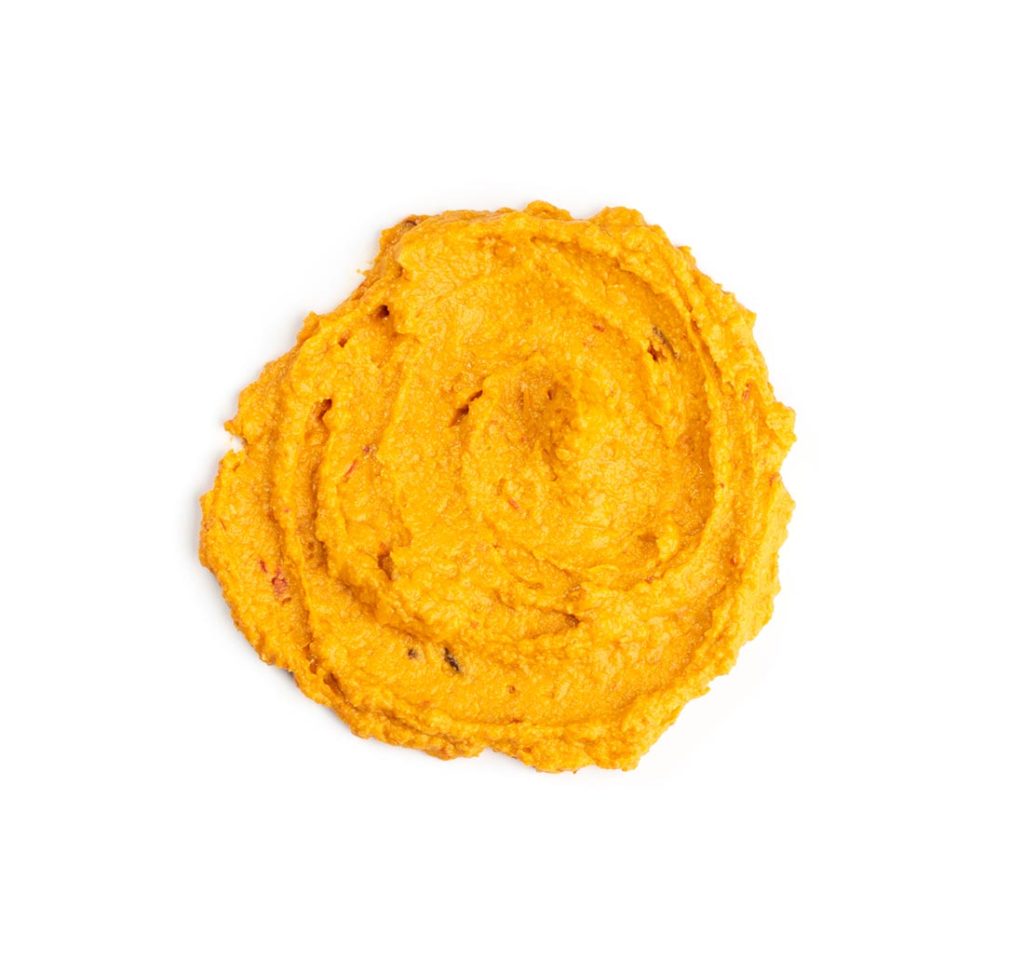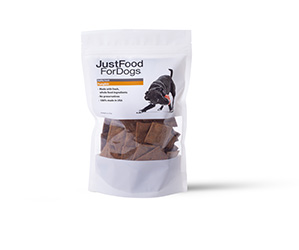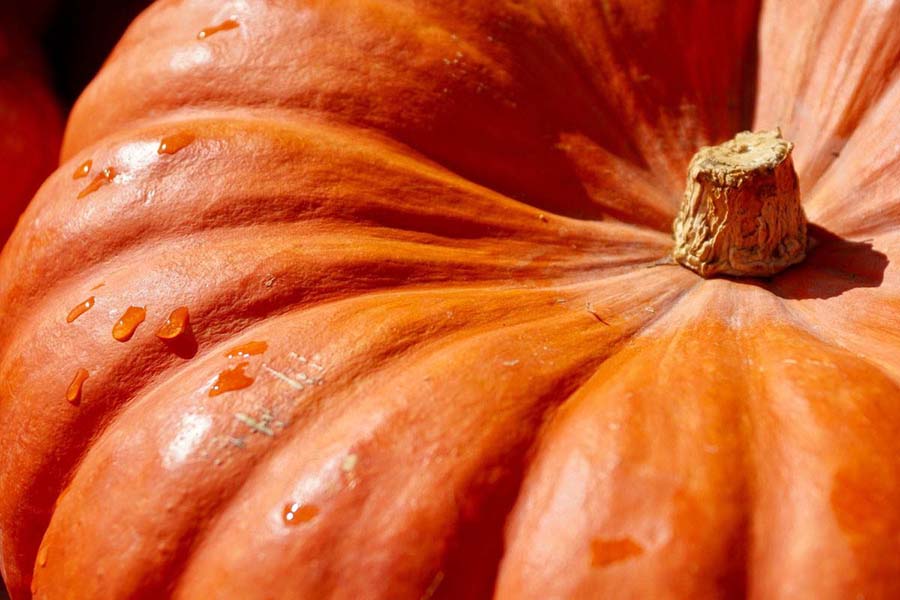Is raw pumpkin good for dogs? When it comes to superfoods, pumpkin for dogs is high atop that list. Pumpkin has evolved into a year-round staple in modern canine diets and for good reasons. It can be used as a tasty, low-calorie dog treat and as part of a healthy diet with its rich supply of vitamin A, antioxidants, fiber, and more.
However, like all things, too much of a good thing isn’t always the best for our pets. To help your dog benefit from delicious, nutritious pumpkin, it’s important to consider its role in your dog’s overall health and diet.
Here’s everything you need to know to get the most out of pumpkin for your pup.
The Health Benefits of Pumpkin

When used as an ingredient in a nutritionally balanced diet, pumpkin can provide dogs with many benefits. Pumpkin is rich in potassium, which improves muscle health and metabolism; Vitamin A to promote healthy eyes and improved skin and coat; Vitamin C to boost immunity; Beta carotene for eye health; and even the seeds are rich in Omega 3 fatty acids, which support a healthy inflammatory response.
But most pet parents know pumpkin for its reputation as a cure-all for digestive issues. Pumpkin is a natural stomach soother for dogs who suffer from occasional bouts of upset stomach, loose stools, or diarrhea — and what pooch doesn’t have a case of “the runs” at some point?
Many pet parents keep canned pumpkin on hand as a remedy for mild cases of diarrhea that don’t merit a visit to the veterinarian. Because pumpkin is fiber-rich, it can help ease a dog’s temporary tummy distress.
What’s more, the versatile squash can also help dogs with the opposite problem. According to the Merck Veterinary Manual, canned pumpkin can act as a stool softener for dogs with mild cases of constipation. In more ways than one, pumpkin is a miracle for the digestive tract!
Cups or teaspoons?
But here’s something most pet parents don’t know, according to Board Certified Veterinary Nutritionist, Dr. Dan Su, MS, DVM, DACVIM-Nutrition. “While pumpkin is healthy and is commonly talked about as a fiber source that helps dogs with diarrhea, constipation, and various other disease processes that may benefit from fiber, a lot of pumpkin would actually be needed to provide a significant amount of fiber,” explains Su.
Su says that pet parents would have to use cups — not teaspoons or tablespoons — as a measurement to derive true nutritional benefit from pumpkin. And it’s best to build up to that amount slowly, so you don’t overwhelm your dog’s digestive system.
According to Su, this is where the problems start. People aren’t clear on how much pumpkin to feed a dog, how to introduce it, or what forms of pumpkin are okay for dogs.
Pumpkin can be a helpful remedy when it comes to digestive woes. But not if you’re serving up too much, too little, or the wrong kind of pumpkin — all of which can do your dog more harm than good.
PUMPKIN FOR DOGS: BALANCE IS KEY
When it comes to how much pumpkin your dog eats, “Too much pumpkin can cause gastrointestinal upset,” according to Dr. Su. “Also, if it’s used as a topper or supplement on top of a complete and balanced diet to provide fiber, too much pumpkin can make the overall diet unbalanced.”
According to PetMD, adding too much fiber from pumpkin or other high-fiber ingredients can decrease the amount of protein and other nutrients a dog’s body can absorb. As a result, the dog is at risk for nutritional deficiencies.
Before adding pumpkin to your dog’s diet, always talk to your veterinarian first, suggests Su. That way, you can be sure that you’re going about it in a nutritionally balanced way and avoid any unintended side effects.
There’s also the chance that pumpkin may have a limited impact on the condition you’re trying to address. Looping your veterinarian in early on will help you get to the right solution faster, avoiding wasted time and suffering.
This is especially important if your dog’s diarrhea or constipation lasts more than a day or two, is accompanied by blood, or if your dog is not drinking or eating. These could be signs of a more serious health condition, so call your dog’s veterinarian right away.
HOW MUCH RAW PUMPKIN SHOULD YOU FEED YOUR DOG?
Like any new food, it’s important to add pumpkin to your dog’s diet slowly and consider body weight. The amount of pumpkin a small dog like a Chihuahua should eat versus the appropriate portion for a Great Dane varies widely. Dr. Su has some specific guidelines:
“If a pet parent wants to try pumpkin for a dog’s digestive health, they can start with one tablespoon per meal per every 20 pounds of dog and increase as needed by 0.5 to 1 tablespoon of pumpkin at a time.” He advises using it until stools return to normal.
Because pumpkin is a starchy vegetable that is high in calories and fiber, it should not exceed more than 10 percent of a dog’s total caloric intake for one day.
HOW TO ADD PUMPKIN TO YOUR DOG’S FOOD

In addition to regulating digestion, pumpkin packs plenty of other health benefits into every bite. The popular squash is incredibly nutritious, and most dogs love its taste, whether you choose to add pumpkin as a topper to your dog’s meal or bake it into treats.
Just keep in mind: Dogs can eat pumpkin and pumpkin products, but not all of them. Pumpkin spice, for one, is a no-go.
“When choosing a pumpkin product, make sure to choose sources that are 100% pumpkin, not pumpkin pie mix,” Su recommends. “So whole pumpkin can be purchased and cooked at home, or plain canned pumpkin would be fine as well.”
What about other forms of pumpkin? Here’s a helpful rundown of common questions pet parents have about pumpkin in all its forms.
CAN DOGS EAT PUMPKIN SEEDS?
Dogs can eat raw pumpkin seeds in moderation. Be warned that they may come out in your dog’s poop looking the same way they went in: whole.
Though not toxic, pumpkin seeds pack a lot of calories (75 calories per single teaspoon). Unless it is a rare treat, it’s best to avoid feeding pumpkin seeds to dogs or adding them to their kibble.
CAN DOGS EAT RAW PUMPKIN?
Regarding whether dogs can eat raw pumpkin, Su says dogs can eat all parts of the pumpkin except for the skin and stems (these parts are a choking hazard). However, “Raw pumpkin should be given in small amounts if used,” Su advises. Raw pumpkin is not toxic, but it isn’t as easily digestible in a dog’s gut as cooked pumpkin.
CAN DOGS EAT PUMPKIN PIE?
Pumpkin pie should not be fed to dogs, as this is a human-only treat. Not only is it high in fat, which can lead to GI upset and pancreatitis, but it can also contain dangerous artificial sweeteners, like Xylitol.
Dr. Su says canned pumpkin is safe, but be sure to purchase pure 100% pumpkin with no added sugars, spices, or fillers, not pumpkin pie mix.
CAN DOGS EAT PUMPKIN BREAD?
With its higher fat content and spices, pumpkin bread can be just as dangerous for your dog as pumpkin pie. So this delicious human food is also on the restricted list for dogs.
However, if you really want to treat your pet to the taste (and nutritional benefits) of pumpkin, consider serving up JustFoodForDogs Pumpkin Treats. The low-protein treat contains only whole-food ingredients and is ideal for all dogs. For dogs that require a hypoallergenic pumpkin treat, JustFoodForDogs has a natural, healthy option with real pumpkin puree as one of the main ingredients.
PUMPKIN FOR DOGS: HELPFUL DOS AND DON’TS

Pumpkin can be a successful addition to pet health if used in moderation and in conjunction with veterinary guidance. Here are some do’s and don’ts to keep in mind when adding pumpkin to your dog’s diet.
WHEN FEEDING YOUR DOG PUMPKIN, DO:
- Choose only 100% pumpkin without added sugars, spices, or fillers when using canned pumpkin, not pumpkin pie filling.
- Read labels carefully. Even if it’s not labeled for pumpkin pie, some canned pumpkin options contain salt. And too much sodium for a dog with kidney or heart disease can be dangerous.
- Try different types of pumpkin to find the one your dog likes best. Fresh pumpkin baked in the oven provides a unique taste and texture. Just be sure to remove the seeds and skin before baking and allow it to cool before feeding to your dog.
- Prepare and store pumpkin safely, if you don’t plan to feed it to your dog right away. Simply slice the fresh, peeled pumpkin into chunks, simmer it in boiling water for 20 to 30 minutes, drain it, mash it, and store it in an airtight container for up to six months in the freezer.
- Provide plenty of cool, clean water to dogs who consume pumpkin or any other fiber-rich ingredients. Foods with high fiber content can cause dogs to dehydrate quickly, which is especially concerning if your dog is also suffering from diarrhea.
- Consider pumpkin as part of a balanced weight management diet. As a low-calorie, high-fiber food, pumpkin can help your pet feel fuller, without adding extra calories. Always work with your veterinarian on any weight management diet, to ensure it meets all your pet’s nutritional needs.
When feeding your dog pumpkin, DON’T:
- Feed pumpkin pie filling, as it contains ingredients that can cause digestive issues and pancreatitis in dogs. Even sugar-free pumpkin pie fillings contain xylitol, a sugar substitute that is very toxic to dogs, causing low blood sugar and liver issues.
- Let your dog have access to jack o’lanterns or carved pumpkins sitting outside during the Halloween season, as they might be rotten and contaminated, which can potentially cause food poisoning if your dog consumes them.
- Overfeed pumpkin to dogs. The GI tract can be compromised if dogs are fed too much pumpkin since it is a natural laxative.
FAST FACTS ABOUT PUMPKIN FOR DOG NUTRITION
Most times, canned or pureed pumpkin can make a healthy dog even healthier. On occasion, canned pumpkin serves as a laxative for constipation or bulking agent for dogs with diarrhea.
But too much pumpkin can be harmful to dogs and may lead to bloating, gassiness, and other unwanted tummy troubles. If a dog stops eating, diarrhea or constipation lasts more than 24 hours, or he has other signs of pain, discomfort, or stomach distress, seek veterinary attention.
Adding a little pumpkin to pet food or feeding him a pumpkin-based treat is a great way to add additional flavor to your pup’s palate. Canned pumpkin and plain fresh pumpkin properly prepared are two of the best ways to help your dog get his fill of this vegetable straight from Mother Nature’s garden.
This content is for informational use only and does not replace professional nutrition and/or medical advice, diagnosis, or treatment. It is not a substitute for and should not be relied upon for specific nutrition and/or medical recommendations. Please talk with your veterinarian about any questions or concerns.
